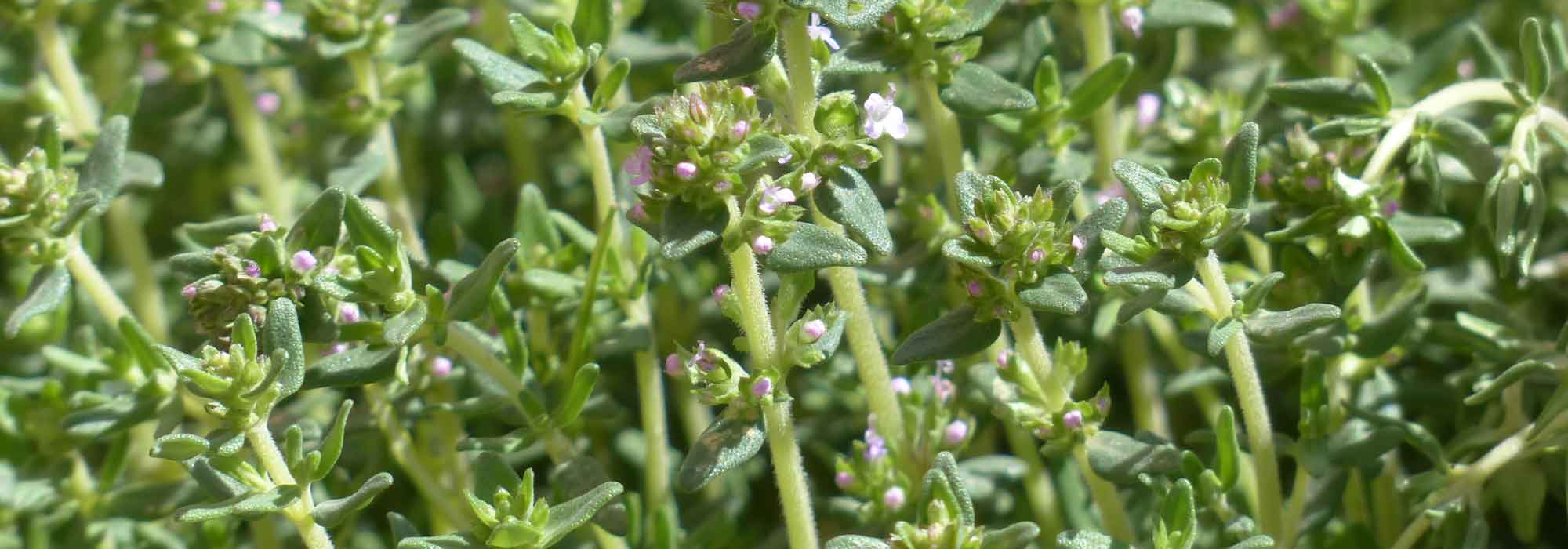
Thyme: growing, planting, pruning
Contents
Thyme in a nutshell
- Thyme is a perennial, aromatic, culinary and medicinal plant.
- It can be grown in the garden but can also be planted in pots, on the terrace or balcony.
- Thyme is a plant that develops without any problems: it loves warmth, sunlight, and well-drained soils.
- The main maintenance consists of annual pruning.
- It is essential in cooking, either alone or in a bouquet garni, and flavours many dishes.
A word from our expert
Thyme is an aromatic, culinary, and medicinal perennial plant, essential in the garden. Its strongly aromatic leaves are used in cooking, either alone or combined with bouquet garni to flavour dishes, but also to make herbal teas with various health benefits.
In gardens, the most commonly found is common thyme (Thymus vulgaris), highly valued for its flavour, ease of cultivation, and good hardiness, as well as wild thyme, used as a fragrant ground cover. Lemon thyme (Thymus x citriodorus), increasingly popular, is grown and appreciated for its freshness. Other, less common varieties are still to be discovered, such as orange thyme with citrus notes or Corsican thyme that evokes cumin!
Easy to grow in open ground, in pots or in window boxes, on a windowsill or on the terrace, it particularly enjoys sunshine, heat, and even dryness, which enhances its fragrance. It can be propagated by sowing, clump division, or propagation by cuttings and can be harvested all year round thanks to its evergreen grey-green foliage.
Feel free to include it at the edge of your vegetable garden, under fruit trees – ensuring it is exposed to sunlight – or in a bed of herbs. Its powerful scent will deter certain species of aphids and molluscs, and during its flowering, it will attract a myriad of pollinating insects. In the garden, do not hesitate to mix things up by placing thyme right in the middle of your perennial flower beds or in rockeries. They will blend in beautifully! Moreover, the sometimes strong scents of aromatic plants often have the ability to repel insects that may attack more sensitive plants like certain roses.
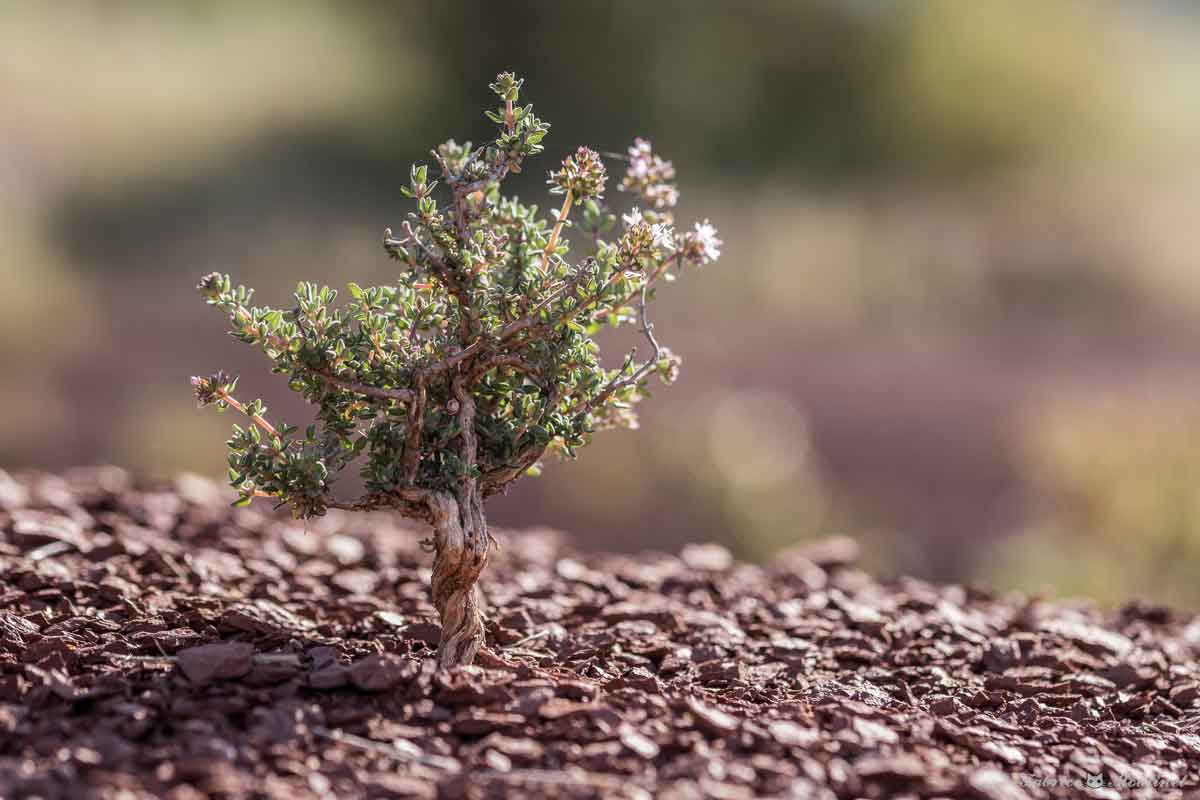 Thyme, in its natural habitat, does not form clumps as generous as in the garden…
Thyme, in its natural habitat, does not form clumps as generous as in the garden…
Description, origin and botany
Botanical data
- Latin name Thymus spp.
- Family Lamiaceae
- Common name Thyme
- Flowering Perennial
- Height 3 years - Germination
- Exposure Sun
- Soil type Dry, well-drained, light
- Hardiness -12°C to -15°C
Thyme is a native plant of Western and Southern Europe, particularly prevalent in the Mediterranean basin as well as in East Asia, including Japan. It is a very resilient plant that thrives in difficult conditions. In the garrigue, it grows in full sun on rocky, dry, and poor soils. The praecox species, which is better adapted to cold, grows spontaneously in Iceland, Ireland, Scotland, and southern England, as well as at altitude in the Alps. Today, the genus Thymus includes over 300 species and varieties.
The genus name Thymus comes from the Greek Thumon, meaning perfume, which refers to the scent exhaled by this highly aromatic plant. Its common name, Thyme, derives from the Greek name and it is also called barigoule or farigoule in the south of France. The wild thyme refers to another species of thyme (Thymus serpyllum) characterised by its creeping habit. It forms very fragrant grassy mats.
Common thyme (Thymus vulgaris) is a perennial undershrub that belongs to the Lamiaceae family. Small in stature, it measures 20 to 40 cm high and forms tufts composed of numerous small ramified stems, herbaceous in the year of growth, woody and twisted for those older than one year. They bear small evergreen leaves, grey-green to silver-green in colour, which are highly aromatic when crushed.
Flowering begins as early as March in its natural habitat – the garrigue – and later in gardens (late spring, early summer). The flowers appear at the ends of the stems, in the axils of the leaves, in the form of cymes of small flowers about half a centimetre long, ranging in colour from white to pink-mauve. The flowers develop into tiny brown seeds, which retain their seed viability for three years. It is common for them to self-seed spontaneously in the vegetable garden.
With good hardiness, thyme can withstand temperatures down to -15°C if the soil is sufficiently drained. This resistance is diminished if the soil is heavy and wet!
Thyme’s flowering is particularly melliferous and attracts many pollinating insects. Beekeepers also harvest thyme honey, which has a rather strong flavour. You may spot this endangered blue butterfly species, which is closely linked to thyme as it lays its eggs on the flower buds of thyme, known as the Thyme blue (Phengaris arion)!
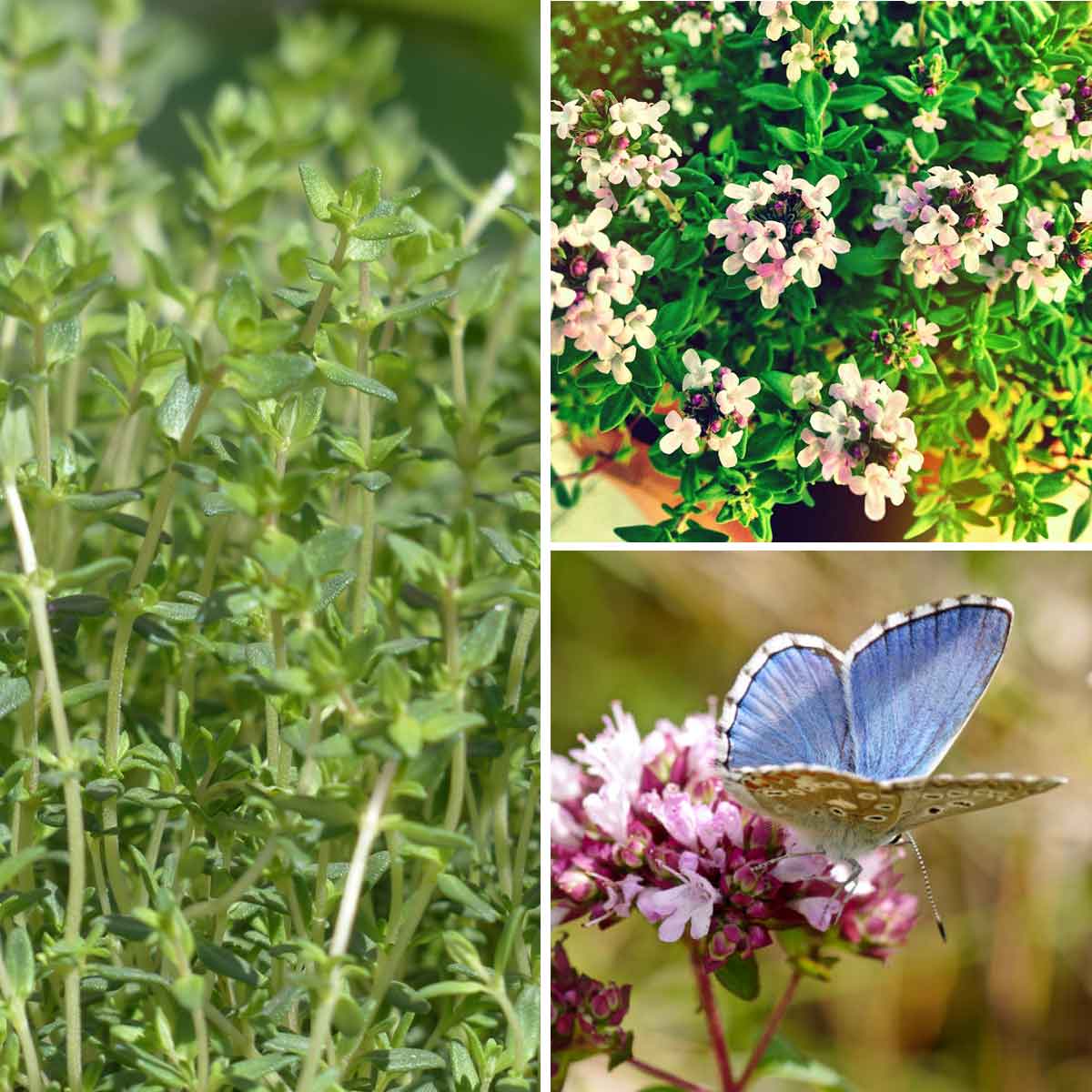
Herbaceous stems of common thyme – Flowering thyme – The Thyme blue butterfly
Read also
Basil: sowing, planting, growingSpecies and varieties of thyme
Among the many species and varieties of thyme, discover below a selection of the best varieties. They are distinguished by their habit, fragrance, flavour, hardiness, and many other characteristics.
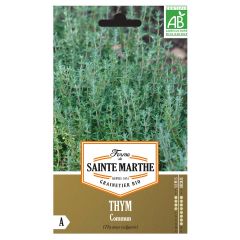
Thymus vulgaris Organic - Ferme de Sainte Marthe seeds
- Höhe bei Reife 25 cm
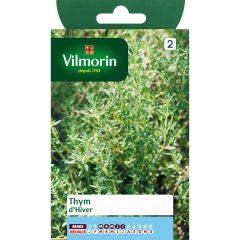
Thymus vulgaris Winter Thyme - Vilmorin seeds
- Höhe bei Reife 30 cm
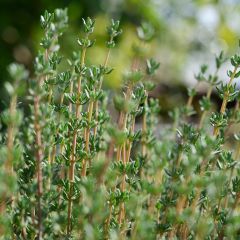
Thymus vulgaris Provence
- Blütezeit July to September
- Höhe bei Reife 25 cm
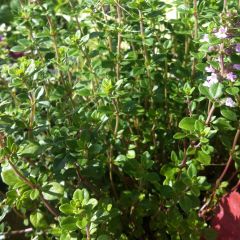
Thymus citriodorus - Lemon Thyme Organic
- Blütezeit July to September
- Höhe bei Reife 25 cm
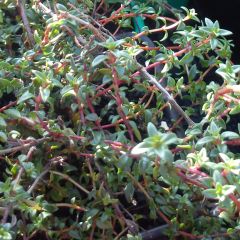
Corsican Thyme - Thymus herba-barona
- Blütezeit July to September
- Höhe bei Reife 15 cm
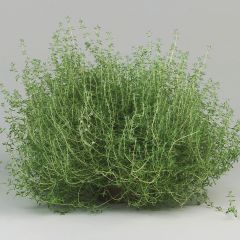
Thymus vulgaris Fragrantissimus - Orange Thyme in plants
- Blütezeit July to September
- Höhe bei Reife 25 cm
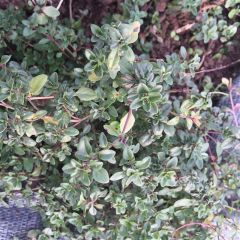
Thymus serpyllum - Ferme de Sainte Marthe seeds
- Blütezeit July to October
- Höhe bei Reife 15 cm
Sowing thyme
Sowing thyme is delicate as the seeds are very small. To ensure success, it is preferable to sow in buckets or trays rather than directly in the ground. Sowing can be done in April May. Additionally, note that sowing thyme requires patience: the first harvest will not begin until the second year.
Sowing in buckets or trays
To sow thyme seeds:
- Fill buckets with special sowing compost.
- Sow the seeds in clusters, with 4 to 5 seeds per cluster.
- Cover with a layer of compost equal to the thickness of the seeds, which means very lightly for thyme!
- Water gently using a water spray and keep the surface moist until germination.
- To encourage germination, cover the buckets with a glass or a plastic bag but remember to ventilate during the day once the seedlings have appeared.
- In autumn or the following spring, depending on the development of the plants, transplant your thyme plants into the ground. Allow 30 cm in all directions between the plants.
Read also
Parsley: sowing, planting, growingPlanting thyme, in the garden or in a pot
Thyme prefers light, even stony, well-drained soils. If your soil is rather damp and clayey, we recommend growing it in a pot where it will thrive. Planting takes place in spring (April-May) or autumn (September-October).
Planting in the ground
Choose a very sunny location; planting should be done in loosened and weeded soil. Space the plants 30 cm apart in all directions.
To plant thyme in the garden:
- Dig a hole that matches the size of the young plant, and enrich it very lightly with mature compost (thyme thrives even in poor soil).
- Place one young plant in each planting hole.
- Cover with soil and gently firm down.
- Water for the first time. Rainwater warmed in the sun is always preferable.
To prevent the appearance of “weeds”, you can mulch around your thyme. However, remember its Mediterranean origins and provide it with a mineral-based mulch instead.
Planting in a pot
To plant thyme in a pot or container:
- Place a layer of gravel or clay balls at the bottom of the container to aid drainage.
- Fill it with an equal mix of potting soil and garden soil, or pure potting soil… if you don’t have a garden!
- Place the root ball, cover with the soil/compost mix, and firm down well.
- Water lightly.
- Place your pot in the sun.
 Thyme grows very well in a pot[/caption>
Thyme grows very well in a pot[/caption>
Discover our advice sheet to successfully grow thyme in a pot.
Pruning thyme and watering
Thyme is an aromatic plant that requires very little maintenance, consisting mainly of pruning and watering, but only in cases of severe and prolonged drought.
Pruning Thyme
Thyme naturally tends to open up and reveal a bare centre, which is not always aesthetically pleasing, especially for pot cultivation. An annual pruning in spring helps maintain a nice rounded and stocky habit. To do this, remove excessively outlying branches and trim back last year’s shoots. Cut back half of the shoot (the herbaceous part) with shears to encourage a dense regrowth.
→ Learn more in our tutorial: Pruning Thyme.
Watering Thyme
Water very moderately (if at all), mainly in summer, as thyme does not appreciate excess moisture. For pot cultivation, water regularly without allowing water to stagnate in the saucer.
Harvest and storage
Thyme can be harvested throughout the year as its leaves are evergreen. It is best to pick it in the morning. Thyme is more fragrant and richer in active ingredients at the beginning of flowering. When you prune it, maintain its beautiful compact shape, and take the opportunity to stock up for the winter months! Ideally, harvest two-thirds of the herbaceous part to encourage regrowth.
Thyme is traditionally preserved by drying. After washing and drying the stems, hang the bunches upside down in a dry, airy, and dark place. Once the thyme is dry, store it away from light. This is a simple and quick operation, and you can replace drying with freezing if that seems more convenient.

Discover our tutorial: How to dry thyme?
Uses and benefits
Thyme leaves, with their garrigue scent, are highly valued in cooking. Used alone or in a bouquet garni, combined with Bay, Parsley, and Rosemary, they flavour stews, sauces, marinades, and court-bouillons. Thyme flowers, less common in cooking, add originality and taste to your dishes! They are used fresh, as soon as harvested, for example, to enhance sauces, season and decorate a dish, or to give a real boost to your desserts and pastries, such as in a lemon cake with thyme flowers.
The properties of thyme are remarkable for alleviating various ailments and for stimulating and strengthening the immune defences. It is a good antiseptic for the respiratory tract. It is most often used as an infusion of leaves (herbaceous stems), but also in the form of essential oils. The latter, depending on their main constituents (their chemotypes), can sometimes be very potent and reserved for adults; always consult your pharmacist before using them.
Read our advice in How to treat a cold naturally with thyme?
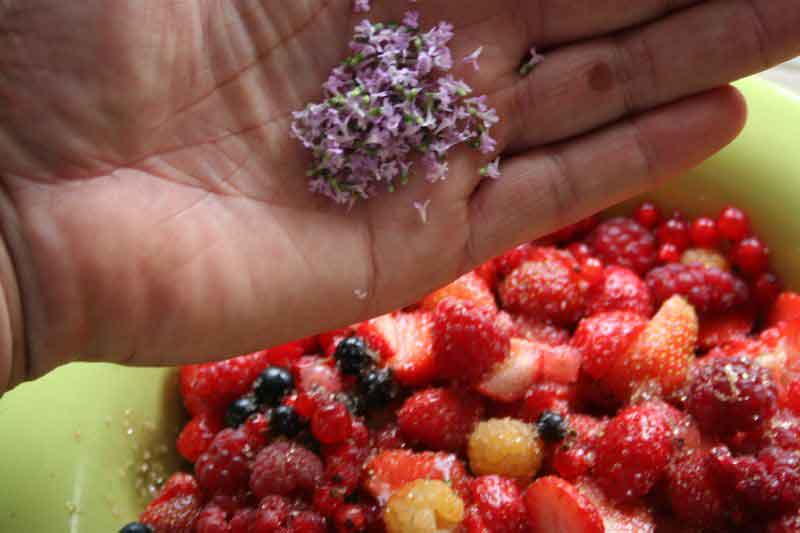
Propagating thyme
Thyme can be multiplied by clump division or by propagation by cuttings, at any season. This operation is recommended after a few years, especially in a cold and damp climate, to renew the plantings.
Dividing the clumps
Clump division is the easiest and most effective method to multiply your thymes. To divide your thyme plants:
- Uproot the clumps.
- Divide into several sections using pruning shears. Ensure that each section has roots.
- Replant the sections in pots or in the ground, covering the collar with soil as well.
- Water to encourage the establishment of the plants.
Taking cuttings
Propagation by cuttings is less recommended than clump division, but it is still possible. To take thyme cuttings:
- Take 20-centimetre-long stems.
- Plant them two-thirds deep in soil and firm down.
- Water regularly for 2 months to promote establishment.
- Transplant in the following spring, in April-May when the risk of frost has passed.
→ Learn more with our tutorial: How to multiply thyme?
Self-seeding
To multiply thyme, also rely on self-seeding! Indeed, after flowering, thyme will produce seeds each year. It is common for some of these seeds to germinate and give rise to new plants near the mother plant. Be attentive during your weeding, as the thyme seedling is quite inconspicuous! Once spotted, simply transplant it to the desired location or let them fill your aromatic patch.
Did you know?
Thyme has been known since antiquity, particularly highlighted by the Greeks who burned it in temples. In Greek mythology, the most beautiful woman in the world and queen of Sparta, Helen (daughter of Zeus and Leda), was charmed by Paris, a Trojan prince, who convinced her to go with him to Troy. Menelaus, Helen’s husband, furious, triggered the Trojan War to retrieve Helen. Legend has it that thyme was born from Helen’s tears.
Useful resources
- Discover our wide range of thyme: many varieties are available as seeds or young plants.
- Also discover creeping thyme as an alternative to lawn
- Read our advice sheet: How to choose thyme?
- Discover 8 aromatic plants for Mediterranean cuisine
- How to soothe a sore throat with thyme?
Frequently asked questions
-
How to keep fresh thyme?
Fresh thyme, harvested in early summer, is rich in flavours and active ingredients, making it the perfect time to stock up. Fresh thyme stores well by freezing. A very practical technique is to freeze it in the form of ice cubes. The thyme is chopped and then placed in ice cube trays filled with water. You can then use the desired amount of ice cubes in your dishes.
-
Are thyme flowers edible?
Thyme flowers are completely edible. Left on the stems (with the leaves), they will flavour various dishes and desserts. They can also be separated from the stem to decorate dishes or add an extra touch to desserts.
-
Why is my thyme drying out and dying?
Thyme decline can be caused by various factors:
- Excess water in the garden or in pots is a possible cause of thyme decline. Soil that is too heavy (too clayey) and waterlogged from autumn to early spring will not be suitable for thyme. - Just as thyme does not like excess water, a lack of water is equally harmful. In the garrigue, in poor and dry soil, thyme will develop according to the medium, meaning that the stems may not be particularly vigorous. In a vegetable garden or in pots, the soil is much richer, and thyme vigorously develops its herbaceous parts. These young plants require more water to meet their higher water needs. They are less resistant to drought than in their natural habitat.
- Subscribe!
- Contents































Comments